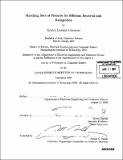| dc.contributor.advisor | Trevor Darrell. | en_US |
| dc.contributor.author | Grauman, Kristen Lorraine, 1979- | en_US |
| dc.contributor.other | Massachusetts Institute of Technology. Dept. of Electrical Engineering and Computer Science. | en_US |
| dc.date.accessioned | 2007-08-03T18:26:44Z | |
| dc.date.available | 2007-08-03T18:26:44Z | |
| dc.date.copyright | 2006 | en_US |
| dc.date.issued | 2006 | en_US |
| dc.identifier.uri | http://hdl.handle.net/1721.1/38296 | |
| dc.description | Thesis (Ph. D.)--Massachusetts Institute of Technology, Dept. of Electrical Engineering and Computer Science, 2006. | en_US |
| dc.description | Includes bibliographical references (p. 145-153). | en_US |
| dc.description.abstract | In numerous domains it is useful to represent a single example by the collection of local features or parts that comprise it. In computer vision in particular, local image features are a powerful way to describe images of objects and scenes. Their stability under variable image conditions is critical for success in a wide range of recognition and retrieval applications. However, many conventional similarity measures and machine learning algorithms assume vector inputs. Comparing and learning from images represented by sets of local features is therefore challenging, since each set may vary in cardinality and its elements lack a meaningful ordering. In this thesis I present computationally efficient techniques to handle comparisons, learning, and indexing with examples represented by sets of features. The primary goal of this research is to design and demonstrate algorithms that can effectively accommodate this useful representation in a way that scales with both the representation size as well as the number of images available for indexing or learning. I introduce the pyramid match algorithm, which efficiently forms an implicit partial matching between two sets of feature vectors. | en_US |
| dc.description.abstract | (cont.) The matching has a linear time complexity, naturally forms a Mercer kernel, and is robust to clutter or outlier features, a critical advantage for handling images with variable backgrounds, occlusions, and viewpoint changes. I provide bounds on the expected error relative to the optimal partial matching. For very large databases, even extremely efficient pairwise comparisons may not offer adequately responsive query times. I show how to perform sub-linear time retrievals under the matching measure with randomized hashing techniques, even when input sets have varying numbers of features. My results are focused on several important vision tasks, including applications to content-based image retrieval, discriminative classification for object recognition, kernel regression, and unsupervised learning of categories. I show how the dramatic increase in performance enables accurate and flexible image comparisons to be made on large-scale data sets, and removes the need to artificially limit the number of local descriptions used per image when learning visual categories. | en_US |
| dc.description.statementofresponsibility | by Kristen Lorraine Grauman. | en_US |
| dc.format.extent | 153 p. | en_US |
| dc.language.iso | eng | en_US |
| dc.publisher | Massachusetts Institute of Technology | en_US |
| dc.rights | M.I.T. theses are protected by copyright. They may be viewed from this source for any purpose, but reproduction or distribution in any format is prohibited without written permission. See provided URL for inquiries about permission. | en_US |
| dc.rights.uri | http://dspace.mit.edu/handle/1721.1/7582 | |
| dc.subject | Electrical Engineering and Computer Science. | en_US |
| dc.title | Matching sets of features for efficient retrieval and recognition | en_US |
| dc.type | Thesis | en_US |
| dc.description.degree | Ph.D. | en_US |
| dc.contributor.department | Massachusetts Institute of Technology. Department of Electrical Engineering and Computer Science | |
| dc.identifier.oclc | 153915528 | en_US |
